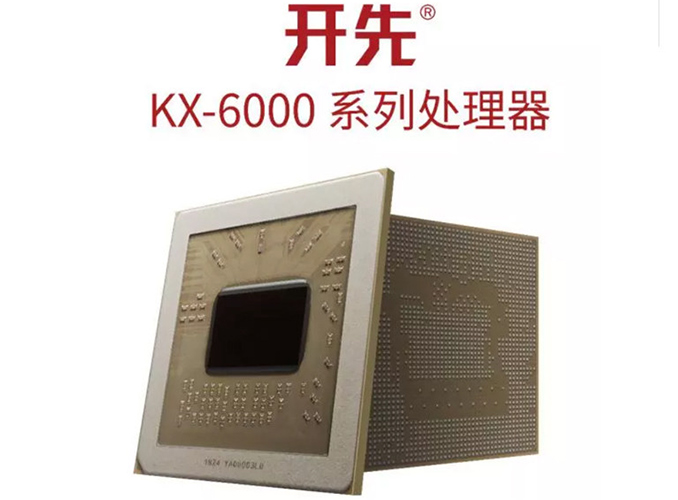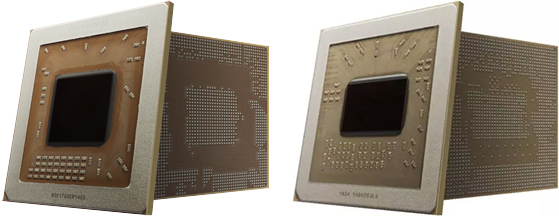Zhaoxin Displays x86-Compatible KaiXian KX-6000: 8 Cores, 3 GHz, 16 nm FinFET
by Anton Shilov on September 24, 2018 12:00 PM EST
Zhaoxin, a joint venture between Via Technologies and the Chinese government, this week for the first time displayed its upcoming x86-compatible CPU, the KaiXian KX-6000. The SoC features eight cores running at 3 GHz and increases performance over its predecessor by at least 50%.
The KaiXian KX-6000 is a successor to the KX-5000 CPU launched earlier this year. Both chips integrate eight-core x86-64 cores with 8 MB of L2 cache, a DirectX 11.1-capable iGPU with an up-to-date display controller, a dual-channel DDR4-3200 memory controller, contemporary I/O interfaces (PCIe, SATA, USB, etc), and so on. The key differences between the KaiXian KX-5000 and the KaiXian KX-6000 are frequencies and manufacturing technology: the former is produced using TSMC’s 28 nm fabrication process and runs at up to 2 GHz, whereas the latter is made using TSMC’s 16 nm technology and operates at up to 3 GHz. Zhaoxin claims that the Kaixian KX-6000 offers compute performance comparable to that of Intel’s 7th Generation Core i5 processor, which is a quad-core non-Hyper-Threaded CPU. Obviously, performance claims like that have to be verified, yet a 50% performance bump over the direct predecessor already seems beefy enough.
As the picture below shows, the thinner manufacturing process enabled Zhaoxin to make the KaiXian KX-6000 die smaller when compared to the predecessor, which will eventually shrink its manufacturing cost. Meanwhile, the two processors use different HFCBGA packaging and therefore cannot use the same motherboards. Meanwhile it is unknown whether the new KaiXian KX-6000 is compatible with Zhaoxin’s USB 3.1 Gen 2-capable ZX-200 chipset.
The Zhaoxin KaiXian KX-6000 relies on the LuJiaZui microarchitecture, which is an evolution of the WuDaoKou microarchitecture that powers the KX-5000 processor introduced in early 2018. Based on what we know today, the LuJiaZui is an x86-64-compatible superscalar, multi-issue, out-of-order microarchitecture that supports contemporary instruction sets extensions like SSE 4.2 and AVX along with virtualization and encryption technologies. Zhaoxin has yet to disclose differences between its LuJiaZui and WuDaoKou designs. Therefore, all we can do is speculate that since the microarchitectures are launched within one year from each other they are very similar, but the newer one has minor optimizations that, perhaps, enable higher clocks, improved caching, better memory support, etc.
Zhaoxin has not announced when it plans to start commercial shipments of its KaiXian KX-6000 processors, as right now it only displays its picture (which proves that it exists). Based on the previously published roadmap, we'd expect the CPU to hit the market in 2019, though when exactly is anyone's guess.
| Zhaoxin's Kaixian KX-5000 and KX-6000 CPUs | |||
| Kaixian KX-5000 WuDaoKou |
Kaixian KX-6000 LuJiaZui |
||
| Core Count | 4 - 8 | Up to 8 | |
| L2 Cache | 8 MB | 8 MB | |
| Frequency | Up to 2 GHz | Up to 3 GHz | |
| ISA | x86-64 | ||
| ISA Extensions | SSE 4.2, AVX | ? | |
| APIC | Yes | ||
| Virtualization | VMX technology, compatible with Intel's VT-X | ||
| Temperature monitoring, overheat protection | Yes | ||
| Power States | C1, C2, C3, C4, P-State | ? | |
| Hardware Encryption Engines | Advanced encryption engine (ACE), SHA-1, SHA-256, SM3/SM4, Randomizer | ? | |
| Security | TXT, EDB | ? | |
| iGPU | DirectX 11.1 feature set. Hardware-accelerated video encoding/decoding. Outputs: DP, eDP, HDMI, D-Sub Max Resolution: 4K Number of Displays: 3 |
? | |
| Packaging | x-ball HFCBGA 37.5 x 37.5 mm |
y-ball HFCBGA 37.5 x 37.5 mm |
|
| Process Technology | TSMC 28 nm | TSMC 16 nm FinFET | |
Related Reading:
- Cypress and Zhaoxin Have USB 3.1 Gen 2 USB Controllers
- China Calling: AMD Forms Joint Venture for x86 Server SoCs in China
- AMD Creates Quad Core Zen SoC with 24 Vega CUs for Chinese Consoles
Source: PC Watch











77 Comments
View All Comments
asdfzxh - Sunday, June 9, 2019 - link
wrongSamus - Wednesday, September 26, 2018 - link
LOL, let the Chinese government buy them up. With wild claims of i5-class performance, I'll see it when I believe it and I doubt any consumer (unless these are dirt cheap) will want something in this performance class. And at 16nm, it is highly unlikely to be competitive on power efficiency. It would likely have to be 100w+ to compete with even an i5asdfzxh - Sunday, June 9, 2019 - link
Cuz you are short sighted and foolish.asdfzxh - Sunday, June 9, 2019 - link
Just you are foolish, and short-sighted. Cepu, buy, do any no matter what and any s ok.Dragonstongue - Monday, September 24, 2018 - link
hmmmm, x86 needs Intel license, I know Via has a license, but do they have ability to maintain this when they "share" to another company?x64 is pretty much AMD (though it uses x85 as backbone) I can picture AMD not giving any trouble about this they WANT an open market, and if 8 cores only operate at 3Ghz then they likely are really in any "trouble" course it all depends on how it performs and how much it costs
seems by spec alone it is "approved" by Intel, otherwise they are facing a massive lawsuit using intel proprietary stuff (AVX, SSE 4.2 and such)
edzieba - Monday, September 24, 2018 - link
"I can picture AMD not giving any trouble about this they WANT an open market"AMD are chasing the volume market, which puts them on a direct collision course with a government-backed 'domestic' volume x86 chip.
CaedenV - Monday, September 24, 2018 - link
Ya, I mean, Ryzen has done a lot of good for market share and stock prices, but AMD's money comes from GPUs and custom chip orders (like consoles).Ryzen will help their bottom line eventuially, but it is going to be a few years before it pays off.HStewart - Monday, September 24, 2018 - link
AMD does not own x64 - but Intel has rights to Core.The big issue is this is from China, and China does not have some of security rights - if this company abuses any of that they are serious trouble and more than just Intel and AMD, meaning government.
I think they are more threat to AMD instead Intel, because they cut at lower price cheaper stuff as AMD been doing.
FirstStrike - Monday, September 24, 2018 - link
Does FX series threat Ryzen? First someone has to do much better than Bulldozer family to make some noticable difference to the MSDT market.rocky12345 - Monday, September 24, 2018 - link
"AMD does not own x64 - but Intel has rights to Core."Here is a quote from Wikipedia
"The original specification, created by AMD and released in 2000, has been implemented by AMD, Intel and VIA. The AMD K8 processor was the first to implement it." They are referring to AMD64 which after Intel licensed from AMD & in turn AMD licenses x86 from Intel AMD's AMD64 is known by everyone as x86-64 now. Hope this helps and informs you that yes AMD does indeed own AMD64.